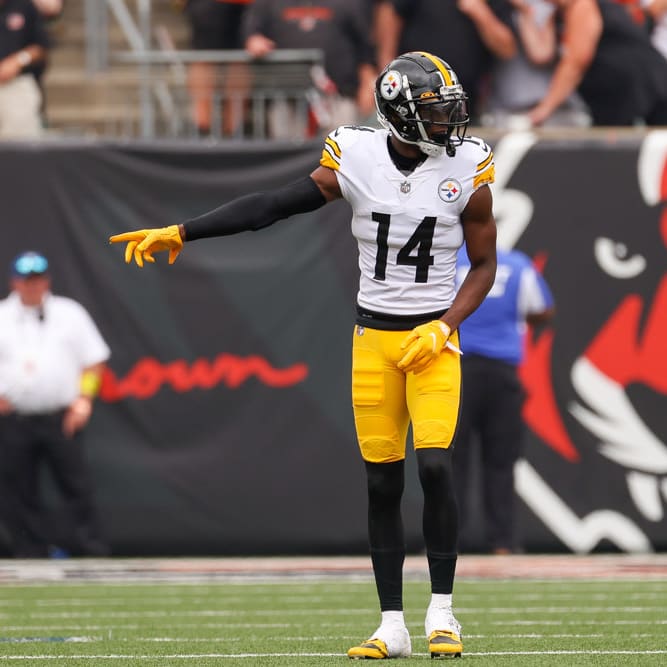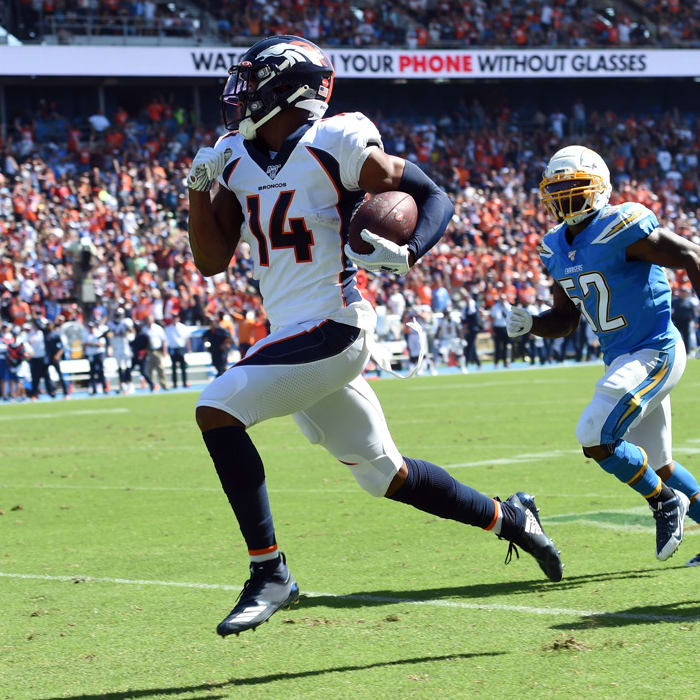This article is part of our Fantasy Football Draft Strategy series.
Running backs are dominating the first round of fantasy drafts again. Given the decline in passing stats the past two seasons, should fantasy football owners reconsider optimal strategy?
I'm a big proponent of taking wide receivers early in fantasy football drafts. Over the last 25 years wide receivers have had higher floors and lower injury risk than running backs, and the drop-off in talent at the position is sharper than for running backs or quarterbacks.
The market for wide receivers is enticing this summer. In almost every format, about 10 of of the top 15 picks are running backs, so it's relatively easy to get one and even two of the top wide receivers in the first two rounds, something that hasn't been the case in recent seasons.
Running backs are prevalent in the top 15 picks of PPR formats and in ADP listings that mix formats (such as ESPN and Yahoo) this summer.
| LEAGUE | WR | RB | QB | TE | FORMAT |
| NFFC | 5 | 10 | 0 | 0 | 12-team PPR, starting 3 WR + Flex |
| MFL | 5 | 10 | 0 | 0 | 12-team non PPR |
| ESPN | 5 | 10 | 0 | 0 | 10-team |
| Yahoo | 5 | 10 | 0 | 0 | 12-team .5 PPR (but includes many formats) |
That contrasts sharply with the same data in mid-August 2017:
| LEAGUE | WR | RB | QB | TE | FORMAT |
| NFFC | 8 | 6 | 1 | 0 | 12-team PPR, starting 3 WR + Flex |
| MFL | 4 | 8 | 2 | 1 | 12-team non PPR |
| ESPN | 8 | 7 | 0 | 0 | 10-team |
| Yahoo | 6 | 9 | 0 | 0 | 12-team non PPR (but includes many formats) |
Though the movement in less pronounced in non-PPR formats.
Top 15 of ADP by Position (12-team, non-PPR)
| YEAR | WR | RB | QB | TE |
| 2018 | 5 | 10 | 0 | 0 |
| 2017 | 4 | 8 | 2 | 1 |
| 2016 | 6 | 7 | 1 | 1 |
| 2015 | 5 | 7 | 2 | 1 |
| 2014 | 6 | 8 | 0 | 1 |
| 2013 | 1 | 12 | 2 | 0 |
| 2012 | 1 | 9 | 5 | 0 |
| 2011 | 3 | 9 | 3 | 0 |
| 2010 | 4 | 8 | 3 | 0 |
| 2009 | 3 | 10 | 2 | 0 |
| 2008 | 2 | 10 | 3 | 0 |
| 2007 | 1 | 13 | 1 | 0 |
| 2006 | 2 | 12 | 1 | 0 |
Wide receivers are less expensive for a reason, however, as their production has declined the past two seasons. That's a significant change from the longer trends in NFL history.
The NFL has seen a rise in passing offense in terms of passing yards per game and as a percentage of total offense since the 1970s due to rule changes and advances in offensive philosophies. Passing yards per game increased 21.6% from 2003-2015 and reached an all-time high of 243.8 passing yards per game in 2015.
That trend has reversed the past two years. Passing yards per game are down 8% the past two seasons and passing touchdowns also declined 13% over that span. Meanwhile, rushing yards increased a little less than one percent the past two seasons.
The fantasy stats of top receivers has suffered as a result. There were only 13 different 1,000-yard wideouts last year, compared to 23 in 2016, 22 in 2015 and 21 in 2014. And there were just two WRs with 10 or more touchdowns last year, while there were five in 2016, 10 in 2015 and 12 in 2014.
Should we consider this a sea change in NFL offensive philosophy? My RotoWire colleague, managing editor Chris Liss, and I recently debated this on our annual NFL Draft Kit podcast. Liss advanced a theory that NFL offenses are increasingly utilizing pass-catching running backs in the realization that the easy yardage gained on those plays is a more efficient play than low-probability deep balls or handoffs to running backs.
And the data appears to back his argument. Running backs caught more passes last year (2,646 to 2,407) despite the decrease in passing stats. Meanwhile, wide receivers had 11 percent fewer catches (6,490 to 5,791) and tight ends had nearly eight percent fewer catches (2,489 receptions to 2,299). The result was running backs had a larger share of the passing offense pie.
Fantasy football still requires starting two or three wide receivers in most formats, so a shrinking receiving pie doesn't mean you can ignore the position. The more important metric may be if a top wideout's value has changed relative to those available in later rounds. Why spend early-round draft capital on a wideout if he's only slightly better than those available in later rounds?
It's true the top wideouts haven't produced the past two seasons compared to earlier in the decade, but they still perform at about the same rate above second- and third-tier receivers. For example, I put together this chart of how the fantasy points for the top wide receiver each season compared to the 28th-, 36th- and 56th-ranked wide receivers at the end of each season. There's a lot of variance but no trend or pattern.
If the gap between top receivers and second- and third-tier options is still wide, there's a case to be made to hoard top wideouts and take your chances on mid-round running backs where you can benefit from the volatility at the position.
It's also possible the recent demise of top receivers is an aberration. Top receivers used to be money in the bank. From 1998 to 2013, just two wideouts of 30 taken in the top 15 of ADP finished outside the top 38 at their position at the end of the season. Since 2014, it's been a different story: five of 22 receivers taken in the top 15 of ADP finished outside the top 38 at season's end.
Performance of Wide Receivers Taken in Top 15 ADP Since 1998
| YEAR | PLAYER | ADP | VBD | FINAL POSITION RANK |
| 1998 | Antonio Freeman | 12.77 | 103 | 2 |
| 1999 | Randy Moss | 7.62 | 97 | 2 |
| 1999 | Antonio Freeman | 14.26 | 24 | 20 |
| 2000 | Randy Moss | 13.4 | 123 | 1 |
| 2000 | Marvin Harrison | 11.06 | 115 | 2 |
| 2001 | Marvin Harrison | 12.87 | 110 | 1 |
| 2001 | Randy Moss | 7.59 | 55 | 5 |
| 2002 | Marvin Harrison | 15.02 | 119 | 1 |
| 2002 | Terrell Owens | 11.46 | 101 | 2 |
| 2002 | Randy Moss | 11.14 | 65 | 5 |
| 2003 | Marvin Harrison | 12.93 | 83 | 5 |
| 2003 | Terrell Owens | 15.72 | 60 | 12 |
| 2004 | Marvin Harrison | 15.91 | 74 | 5 |
| 2004 | Randy Moss | 12.24 | 28 | 19 |
| 2005 | Randy Moss | 13.98 | 32 | 15 |
| 2006 | Steve Smith | 15.63 | 60 | 8 |
| 2008 | Terrell Owens | 14.51 | 53 | 9 |
| 2008 | Randy Moss | 9.85 | 51 | 10 |
| 2009 | Larry Fitzgerald | 8.71 | 75 | 5 |
| 2009 | Andre Johnson | 12.75 | 100 | 1 |
| 2009 | Randy Moss | 13.26 | 92 | 2 |
| 2010 | Andre Johnson | 6.92 | 56 | 6 |
| 2010 | Larry Fitzgerald | 12.19 | 35 | 16 |
| 2010 | Randy Moss | 14.26 | -46 | 67 |
| 2011 | Roddy White | 13.21 | 62 | 8 |
| 2011 | Andre Johnson | 13.56 | -54 | 71 |
| 2011 | Calvin Johnson | 15.65 | 149 | 1 |
| 2012 | Calvin Johnson | 6.63 | 149 | 1 |
| 2013 | Calvin Johnson | 9.32 | 9.32 | 3 |
| 2014 | Calvin Johnson | 4.16 | 43.5 | 38 |
| 2014 | Demaryius Thomas | 7.52 | 115.7 | 9 |
| 2014 | Dez Bryant | 9.08 | 115.8 | 8 |
| 2014 | A.J. Green | 9.51 | 28.1 | 47 |
| 2014 | Julio Jones | 13.1 | 83.2 | 17 |
| 2014 | Brandon Marshall | 14.71 | 7.9 | 74 |
| 2015 | Antonio Brown | 8.61 | 126 | 1 |
| 2015 | Demaryius Thomas | 14.19 | 40 | 13 |
| 2015 | Odell Beckham | 14.31 | 99 | 5 |
| 2015 | Juio Jones | 15.5 | 113 | 2 |
| 2015 | Dez Bryant | 11.4 | -73 | 79 |
| 2016 | Antonio Brown | 2.4 | 81 | 3 |
| 2016 | Odell Beckham | 4.67 | 69 | 4 |
| 2016 | Julio Jones | 6.74 | 53 | 6 |
| 2016 | A.J. Green | 11.57 | -104 | 35 |
| 2016 | DeAndre Hopkins | 12.5 | -97 | 38 |
| 2017 | Antonio Brown | 4.69 | 99 | 2 |
| 2017 | Odell Beckham | 8.96 | -82 | 78 |
| 2017 | Julio Jones | 7.69 | 51 | 6 |
| 2017 | Mike Evans | 11.34 | 22 | 18 |
| 2017 | AJ Green | 14.69 | 39 | 10 |
| 2017 | Jordy Nelson | 14.83 | -67.9 | 49 |
Three of the five recent busts were somewhat fluky injuries. Odell Beckham broke his ankle last year. Dez Bryant played just nine games in 2015 due to a foot injury. Brandon Marshall missed three games in with an ankle injury in 2014. A.J. Green missed three games with three different ailments in 2014.
It's also the case that wide receiver injuries are just catching up to the rates of other positions after a run of good luck. With the recent spate of wide receiver injuries, the bust rate (defined as a player who would not finish the season worthy of a starting spot in a 12-team league) of wideouts has climbed to 17% since 1998. Running backs have a bust rate of 19% since 1998.
Another reason to think the demise of receivers is a mirage is that there are no significant rule changes that have resulted in the decline in wide receiver production the past two years. While offensive coordinators have increasingly turned to pass-catching running backs, that strategy could change if defenses expend more resources on linebackers who can cover running backs in the passing game. The NFL is a constant ebb-and-flow between defensive strategy.
With no overriding reason for the decline of wide receivers in the face of a long-term trend of rising passing stats, it may be best to ignore the recent trend and buy receivers while they are cheap. At least until more data shows we're back to an era where running backs are king again.












